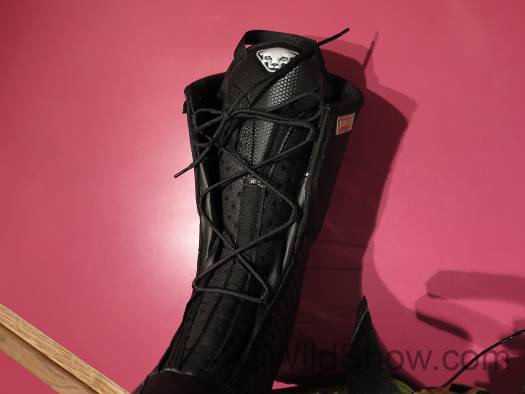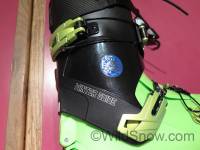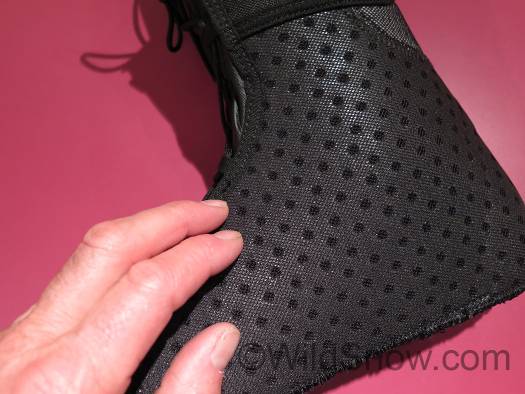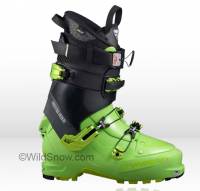
Dynafit Winter Guide boot has a liner that promises dryer feet. They do have a real sample here in France that I got my hands on, this is a PR shot. Click to enlarge.
I put this report in a separate blog post because I think it’s a big deal. Not because of the boot, which is really just a simplified TLT-6 made from Pebax instead of Grilamid (same shell as Dynafit Neo), but because of the liner. For years, various ski touring boot companies have been working on the sweaty foot problem. Solutions seem to usually involve making the liner with a Gore-tex interior sock that helps moisture from warm moist feet end up outside the comfort area and in the liner foam next to the shell. In other words, (the claim is) when you dry your liners they’re wet on the outside instead of the inside (and of course need to be removed from the shell to dry quickly).
So what’s the problem? Why don’t all ski touring boots have these “dry” liners? In my view the challenges are many. For starters, the modern dry liner needs to respond to thermo molding. Yet at the same time it has to be exactly the right foam to move moisture from your foot, through a membrane, then “breathed” out into the exterior liner foam. Getting all those ingredients to work together is tricky.
Interestingly, back in the early 1980s the red Dynafit touring boot (made famous as the first boot to be manufactured with tech fittings) had a Goretex liner that actually provided a bit of function in keeping your feet dry. It was a wimpy, non-molding liner that wore out quickly. But I remember it well and how comfortable my feet were in terms of swamp action, despite the fact that many people found the boot super difficult to fit.
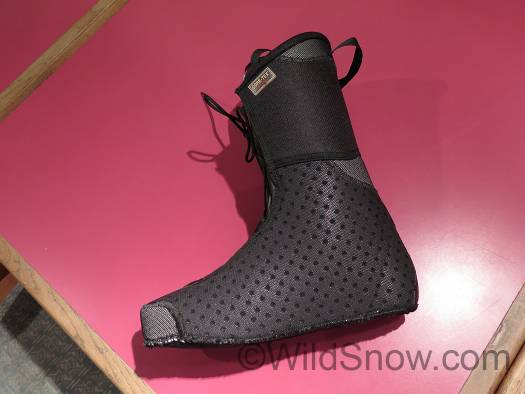
Liner is studded with holes that breath out from the Gore-tex liner, but don’t let the water back in.
In any case, we’re excited about this technology (something like it is offered by Scott as well, and we’ve not done enough testing yet to have a good take) and we’ll get a pair of these boots into a “swamp foot” testing situation just as soon as the injection molding mills of Montebelluna allow.
Regarding the name of the boot, it alludes to the fact that guides spend max hours in their boots and problems with foot moisture run the gamut from cold feet to actual medical disorders such as immersion foot.
The wet question is of course can we swap this liner into other boot shells we might like better? I’d imagine that’s physically easy, but no word yet on if the liners will be readily available in retail. No idea yet on MSRP but availability will begin during fall of 2015-2016.
Following is the official spiel, edited for clarity and brevity:
Ski touring specialist DYNAFIT in partnership with the International Federation of Mountain Guides Associations (IFMGA) has developed a new ski boot, the Winter Guide GTX®. Thanks to an intelligent liner, this boot will keep feet dry and warm… Big innovation (here at WildSnow we agree) with Winter Guide GTX® is the liner. A layer of GORE-TEX® membrane allows moisture to escape through ventilation perforations to the surface of the liner. Besides the moisture control and the quality of the liner, the Winter Guide GTX® offers a long list of other features that are characteristic of Dynafit boots. The Pebax shell with its Flex Tongue Design enables unique cuff rotation as good downhill flex (Wildsnow: always the challenge with tongue boots). The Ultra Lock Closure System 2.0 allows quick transitions between walk and ski modes with one flick… (WildSnow: I’m not sure how important the following is, but no reason not to clarify) Certain Dynafit products are developed together with the IFMGA mountain guides as a partnership, and have an integrated IFMGA (IVBV) “tested and approved” logo at retail — as does the Winter Guide GTX®.
WildSnow.com publisher emeritus and founder Lou (Louis Dawson) has a 50+ years career in climbing, backcountry skiing and ski mountaineering. He was the first person in history to ski down all 54 Colorado 14,000-foot peaks, has authored numerous books about about backcountry skiing, and has skied from the summit of Denali in Alaska, North America’s highest mountain.

